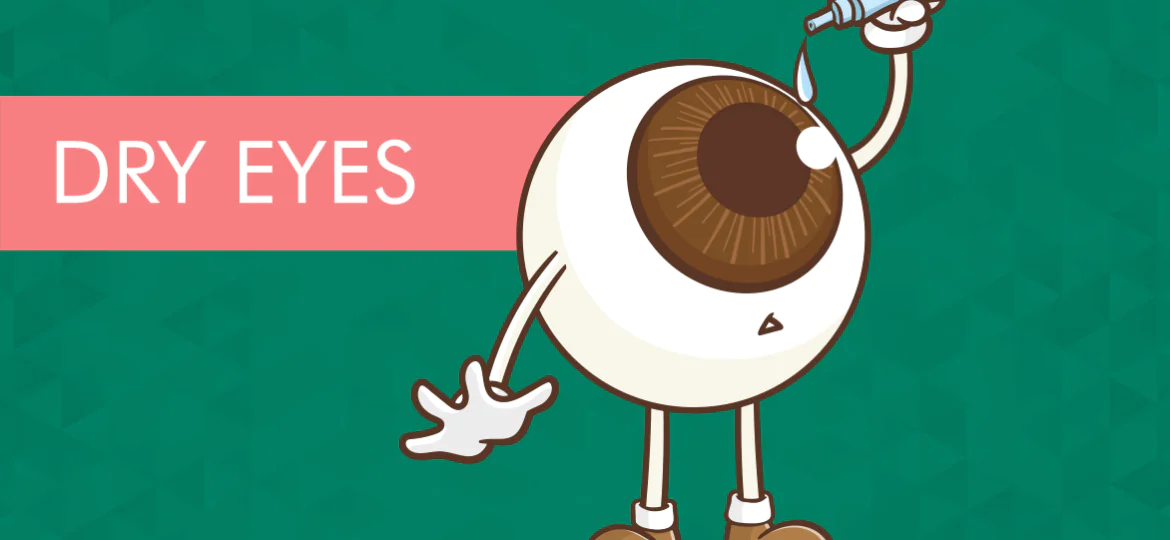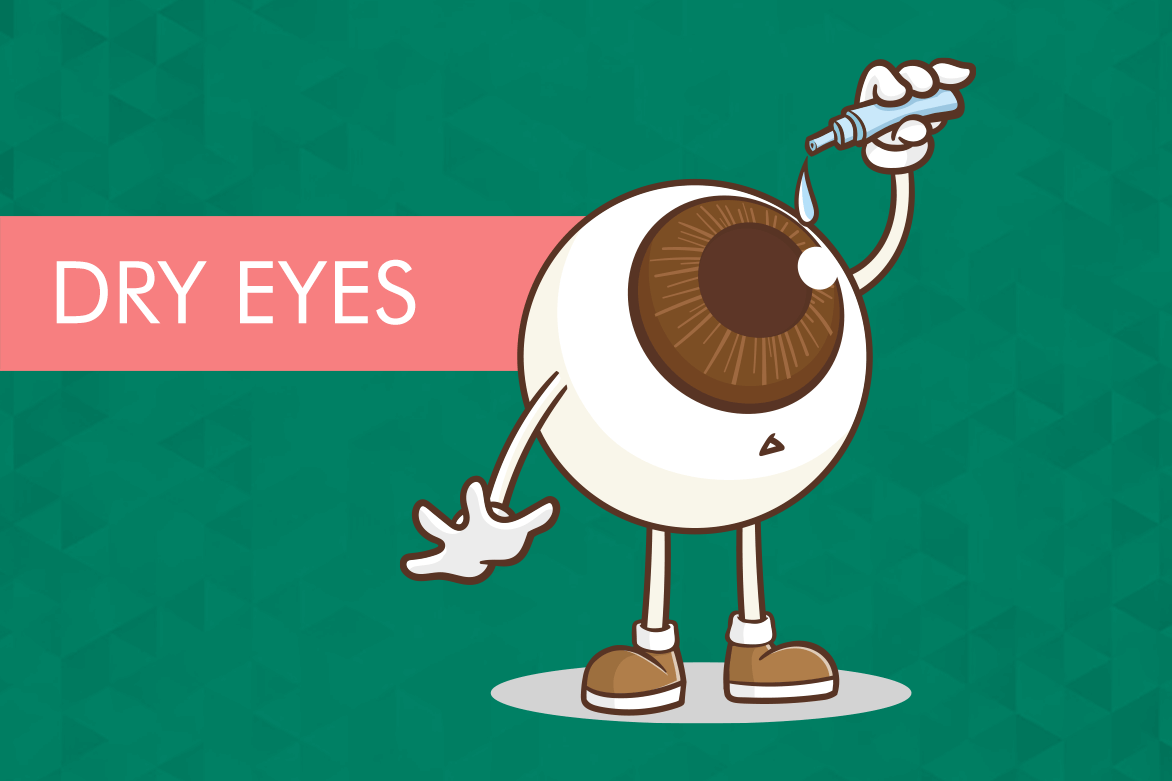
Common Signs And Symptoms of Dry Eyes

In the hustle and bustle of our daily lives, we often take our eyes for granted. But when they start to feel dry and irritated, it’s a reminder that our body’s intricate systems sometimes need a little TLC. Dry eyes, a condition affecting millions worldwide, can range from a minor annoyance to a significant discomfort. Understanding
dry eye symptoms is crucial for effective management and relief. In this blog, delve into an array of dry eye disease symptoms, gaining insights into the various ways this condition can manifest and impact your eye health.
What are dry eyes ?
Dry eyes, also known as dry eye syndrome or keratoconjunctivitis sicca, is a common eye condition characterized by a lack of adequate lubrication and moisture on the ocular surface. In individuals who have dry eye syndrome symptoms, the quantity or quality of tears is insufficient to keep the eyes adequately moist and nourished. Research studies continue to investigate innovative approaches to dry eyes symptoms and treatment, aiming to enhance effectiveness and patient outcomes.
Causes of Dry eyes
Dry eye symptoms can stem from various factors, ranging from environmental influences to underlying medical conditions. Here are some common contributors to dry eyes:
- Aging, which often causes decreased tear production.
- Environmental factors such as dry climates and wind increase dryness.
Read about Winter Eyecare Tips by experts.
- Excessive screen time reduces blinking, leading to dryness.
Follow the 20-20-20 rule (every 20 minutes, look at something 20 feet away for at least 20 seconds) to reduce eye strain.
- Hormonal changes such as menopause and pregnancy affect tear production.
- Medical conditions such as autoimmune diseases impact tear production.
- Usage of medications may reduce tear production.
- Eyelid disorders such as blepharitis can interfere with tear production, making eyes dry.
- Improper use of contact lenses may lead to dryness.
- Nerve disruption due to refractive eye surgery may cause dryness.
- Environmental allergens such as pollen and dust may worsen dry eyes.
Eye Care During Pollution – Dos and Don’ts
Dry Eye Symptoms
Imagine blinking and feeling like sandpaper is rubbing against your eyes. Or experiencing a persistent sensation of grittiness, itching, or burning. These are just some of the telltale signs of dry eye, which indicate that your tears aren’t providing adequate lubrication for your eyes. Common dry eye symptoms include:
Dryness
One of the first signs of dry eye is dryness, of course. Individuals with dry eyes often experience a persistent sensation of dryness or parchedness in their eyes, as if there’s not enough moisture to keep them comfortably lubricated.
Redness
Dry eyes can lead to redness due to irritation and inflammation of the conjunctiva, the thin, transparent layer covering the white part of the eye. This redness is a visible dry eye disease symptom and can vary in intensity depending on the severity of dryness and individual sensitivity.
Burning or Stinging
Many people with signs of dry eyes describe a burning or stinging sensation, akin to the feeling of having something irritating or abrasive in their eyes. This discomfort can be particularly pronounced in environments with dry air or when exposed to irritants like smoke or dust. This is one of the most commonly experienced dry eye symptoms.
Watery eyes
Paradoxically, dry eyes can trigger excessive tearing as the eyes attempt to compensate for the lack of adequate moisture. However, these tears are often of poor quality and do not effectively lubricate the ocular surface.
Blurry vision
Dry eyes can cause blurred or fluctuating vision. This blurriness may worsen during activities that require prolonged focus, such as reading or using digital devices, and can be temporarily relieved by blinking or using artificial tears, leading to eye dryness symptoms.
Sensitivity to light
Photophobia, one of the dry eye syndrome symptoms, means eyes can become sensitive to light. Individuals may find it uncomfortable or even painful to be in brightly lit environments.
Difficulty wearing contact lenses
Many signs of dry eyes pose challenges for contact lens wearers, as the lenses can exacerbate dryness and discomfort. Individuals may experience difficulty inserting or removing lenses, increased lens awareness or discomfort during wear, and reduced wearing time before experiencing dry eye disease symptoms.
Stringy mucus
In some cases of dry eye syndrome symptoms, inadequate tear production or composition can lead to the formation of stringy or rope-like mucus strands in the tears. This mucus can accumulate along the eyelid margins or float in the tear film, causing discomfort and visual disturbances.
Risks and Complications With Dry Eyes
Risks and complications associated with dry eye symptoms extend beyond mere discomfort and inconvenience, potentially impacting both ocular health and overall well-being. Understanding these risks is crucial for prompt intervention and effective management. Here are some key considerations if you face any dry eye syndrome symptoms:
- Corneal damage: Prolonged dryness can result in corneal abrasions or ulcers, potentially leading to pain and vision disturbances.
- Increased risk of infection: eye dryness symptoms, if persisted for longer, can cause insufficient tears to compromise the eye’s natural defense, raising the likelihood of bacterial or viral infections such as conjunctivitis or keratitis.
- Corneal scarring: Chronic dryness may induce the formation of scar tissue on the cornea, impairing vision and potentially requiring surgical intervention.
- Decreased quality of life: Ongoing discomfort and vision issues can affect daily activities, leading to frustration and reduced enjoyment of life.
- Compromised visual function: Blurred vision and discomfort can hinder performance in tasks requiring visual acuity, impacting work or academic performance.
- Chronic discomfort: Untreated eye dryness symptoms can lead to persistent discomfort and eye fatigue, affecting mood and overall well-being.
- Impact on contact lens wear: Dry eyes pose challenges for contact lens wearers, leading to discomfort and potential complications such as corneal abrasions.
Also Read about Eye Infections from Contacts
Preventive Measures For Dry Eyes
While many treatment options exist, prevention plays a vital role in minimizing the risk of developing dry eye symptoms and maintaining optimal ocular comfort. Consulting with an eye care professional is recommended for personalized assessment and guidance on managing dry eyes symptoms and treatment. However, by implementing proactive measures and lifestyle modifications, individuals can safeguard their eyes against the signs of dry eyes and eye dryness symptoms:
- Blink regularly to keep eyes moist and lubricated.
- Take frequent breaks to rest your eyes during screen time.
- Use a humidifier to add moisture to indoor air.
- Wear sunglasses outdoors to protect against wind and UV rays.
- Position screens below eye level to reduce strain.
Explore more about What is Digital Eye Strain, and how to treat it?
- Stay hydrated by drinking plenty of water.
- Include omega-3 rich foods in your diet for eye health.
- Avoid smoke and other eye irritants.
- Wear protective eyewear in windy or dusty environments.
- Follow proper contact lens hygiene to prevent dryness.
The impact of chronic dry eye symptoms on daily activities underscores the importance of proactive management and personalized treatment approaches. By incorporating simple lifestyle modifications such as staying hydrated, practicing good eyelid hygiene, and minimizing exposure to environmental irritants, individuals can help prevent dry eye symptoms and maintain optimal eye health. Remember, your eyes deserve the same care and attention you give to the rest of your body. So, if you’re experiencing eye dryness symptoms, don’t hesitate to seek professional guidance and support. Your eyes will thank you for it.
FAQs
How do you deal with dry eyes?
Use lubricating eye drops or artificial tears to relieve dry eye symptoms and discomfort.
What causes Dry Eyes?
Factors include aging, environmental conditions, hormonal changes, and certain medications.
What is the best solution for dry eyes?
Treatment options include artificial tears, lifestyle adjustments, and prescription medications based on severity.
Is dry eye syndrome a chronic condition?
Yes, dry eye syndrome can be a chronic condition. For those with chronic dry eye symptoms, finding the right treatment approach is key to improving overall well-being. Understanding dry eyes symptoms and treatment options can help you manage the discomfort associated with it.
Can contact lenses worsen dry eyes?
Yes, contact lenses can exacerbate dry eye symptoms, leading to discomfort and reduced wearing time.
